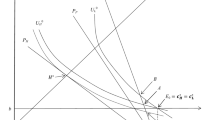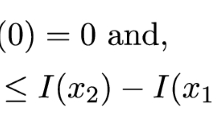Abstract
The demand for insurance is examined when the insured asset can incur losses that are excluded from insurance coverage. These losses are negatively correlated with covered losses and hence cannot be treated as background risk. Excluded losses have strikingly different effects on the demand for insurance than does background risk and lead to a modification of many standard insurance demand results. A number of new theorems concerning the effects of excluded losses are also presented. Risk-averse and prudent decision makers reduce their demand for insurance when excluded losses increase in size or riskiness. Excluded losses are a possible explanation for why many decision makers fail to take up insurance when it is offered.
Similar content being viewed by others
Notes
We recognize that sometimes excluded and covered losses occur simultaneously. An important example involves damage to a home caused by a storm or hurricane. Often the wind damage is covered, while the flood damage is excluded. The model here abstracts from that possibility.
The outcome variable to the decision maker consists of the values of the assets minus the values of the various losses that occur. As a consequence whether an unreimbursed loss occurs to a particular asset or to another asset makes no difference to the final outcome. It is the case that the defining property of both background risk and excluded losses is the nature of the joint probability distribution function with insured losses, not the asset to which the loss applies.
Assuming that (x1, x 2) is distributed according to g(x1, x 2) described in (1), differentiates excluded risks from background risks. For background risks, g(x1, x 2) would be assumed to satisfy g(x1, x 2) = h1(x1)·h2(x 2) for where hi are density functions. The uninsured loss x 2 can represent a loss to the asset being insured or a loss to another asset.
In the same model where x 2 is interpreted as background risk and hence independently distributed, there is also a reduction of expected utility over a bi-variate distribution to a term involving only a single random variable. In that analysis, however, u(W) is replaced by its expectation with respect to x 2. This expectation is increasing and concave whenever u(W) is, and also displays more risk aversion than does u(W). See Eeckhoudt and Kimball (1992) for details.
This same assumption is made by Ehrlich and Becker (1972) in their model of self protection and in the literature that extends their work.
In the standard model of deductible insurance, the only excluded losses are those that fall below the level of the deductible.
References
Briys, E., & Schlesinger, H. (1990). Risk aversion and the propensities for self-insurance and self-protection. Southern Economic Journal, 57(2), 458–467.
Chiu, W. H. (2005). Degree of downside risk aversion and self-protection. Insurance: Mathematics and Economics, 36(1), 93–101.
Dionne, G., & Eeckhoudt, L. (1985). Self-insurance, self-protection, and increased risk aversion. Economics Letters, 17, 39–42.
Doherty, N., & Schlesinger, H. (1983). The optimal deductible for an insurance policy when initial wealth is random. Journal of Business, 56, 555–565.
Doherty, N., & Schlesinger, H. (1990). Rational insurance purchasing: consideration of contract nonperformance. The Quarterly Journal of Economics, 105(1), 243–253.
Eeckhoudt, L., & Kimball, M. (1992). Background risk, prudence and the demand for insurance. In G. Dionne (Ed.), Contributions to insurance economics. Boston: Kluwer.
Eeckhoudt, L., & Gollier, C. (2005). The impact of prudence on optimal prevention. Economic Theory, 26, 989–994.
Eeckhoudt, L., Gollier, C., & Schlesinger, H. (1991). Increases in risk and deducible insurance. Journal of Economic Theory, 55, 435–440.
Eeckhoudt, L., Gollier, C., & Schlesinger, H. (1996). Changes in background risk and risk taking behavior. Econometrica, 64, 683–689.
Ehrlich, I., & Becker, G. S. (1972). Market insurance, self-insurance and self-protection. Journal of Political Economy, 80, 623–648.
Gollier, C., & Schlesinger, H. (1996). Arrow’s theorem on the optimality of deductibles: a stochastic dominance approach. Economic Theory, 7, 359–363.
Jullien, B., Salanie, B., & Salanie, F. (1999). Should more risk-averse agents exert more effort? The Geneva Papers on Risk and Insurance Theory, 24, 19–28.
Kihlstrom, R. E., Romer, D., & Williams, S. (1981). Risk aversion with random initial wealth. Econometrica, 49, 911–920.
Liu, L., Rettenmaier, A. J., & Saving, T. R. (2009). Conditional payments and self-protection. Journal of Risk and Uncertainty, 38, 159–72.
Menezes, C., Geiss, C., & Tressler, J. (1980). Increasing downside risk. American Economic Review, 70(5), 921–932.
Meyer, D. J., & Meyer, J. (1998). Changes in background risk and the demand for insurance. The Geneva Papers on Risk and Insurance Theory, 23(1), 29–40.
Nachman, D. C. (1982). Preservation of ‘more risk averse’ under expectations. Journal of Economic Theory, 28, 361–368.
Quiggin, J. (2002). Risk and self-protection: a state-contingent view. Journal of Risk and Uncertainty, 25, 133–45.
Rothschild, M., & Stiglitz, J. (1970). Increasing risk I: a definition. Journal of Economic Theory, 2, 225–243.
Sweeney, G. H., & Beard, T. R. (1992). The comparative statics of self-protection. The Journal of Risk and Insurance, 59(2), 301–309.
Acknowledgement
The authors thank the editor and a reviewer for helpful comments.
Author information
Authors and Affiliations
Corresponding author
Rights and permissions
About this article
Cite this article
Meyer, D.J., Meyer, J. Excluded losses and the demand for insurance. J Risk Uncertain 41, 1–18 (2010). https://doi.org/10.1007/s11166-010-9095-8
Published:
Issue Date:
DOI: https://doi.org/10.1007/s11166-010-9095-8




